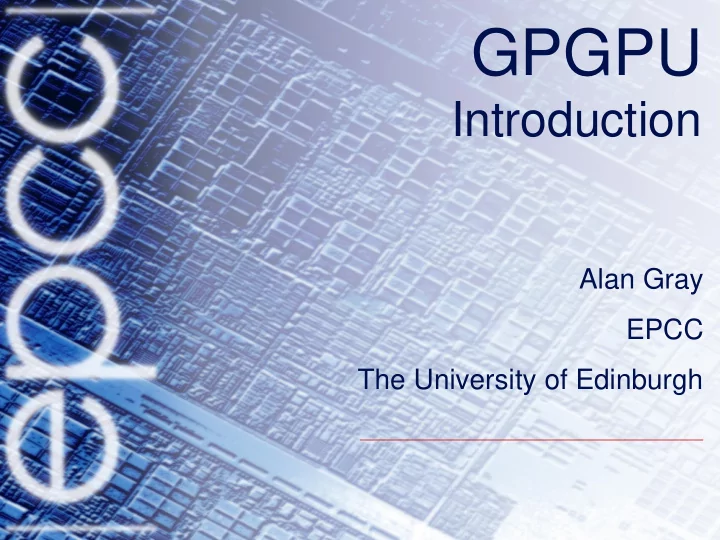

GPGPU Introduction Alan Gray EPCC The University of Edinburgh
Introduction • Central Processing Unit (CPU) of a computer system must be able to perform a wide variety of tasks efficiently. • Until (relatively) recently, most CPUs comprised of 1 sophisticated compute core (for arithmetic), plus complex arrangement of controllers, memory caches, etc • Increases in CPU performance were achieved through increases in the clock frequency of the core. – This has now reached it’s limit mainly due to power requirements • Today, processor cores are not getting any faster, but instead we are getting increasing numbers of cores per chip. – Plus other forms of parallelism such as SSE,AVX vector instruction support • Harder for applications to exploit such technology advances. Alan Gray 2
Introduction Meanwhile…. • In recent years computer gaming industry has driven development of a different type of chip: the Graphics Processing Unit (GPU) • Silicon largely dedicated to high numbers (hundreds) of simplistic cores, – at the expense of controllers, caches, sophistication etc • GPUs work in tandem with the CPU (communicating over PCIe), and are responsible for generating the graphical output display – Computing pixel values • Inherently parallel - each core computes a certain set of pixels • Architecture has evolved for this purpose Alan Gray 3
Introduction • GPU performance has been increasing much more rapidly than CPU • Can we use GPUs for general purpose computation? – Yes (with some effort). Alan Gray 4
GPGPU • GPGPU: General Purpose computation on Graphics Processing Units. • GPU acts as an “accelerator” to the CPU (heterogeneous system) – Most lines of code are executed on the CPU (serial computing) – Key computational kernels are executed on the GPU (stream computing) – Taking advantage of the large number of cores and high graphics memory bandwidth – AIM: code performs better than use of CPU alone. • GPUs now firmly established in HPC industry – Can augment each node of parallel system with GPUs Alan Gray 5
GPGPU: Stream Computing • Data set decomposed into a stream of elements • A single computational function ( kernel ) operates on each element – “thread” defined as execution of kernel on one data element • Multiple cores can process multiple elements in parallel – i.e. many threads running in parallel • Suitable for data-parallel problems Alan Gray 6
Programming Considerations • Standard (CPU) code will not run on a GPU unless it is adapted • Programmer must – decompose problem onto the hardware in a specific way (e.g. using a hierarchical thread/grid model in CUDA) – Manage data transfers between the separate CPU and GPU memory spaces. – Traditional language (C, C++, Fortran etc) not enough, need extensions, directives, or new language. • Once code is ported to GPU, optimization work is usually required to tailor it to the hardware and achieve good performance • Many researchers are now successfully exploiting GPUs – Across a wide range of application areas Alan Gray 7
Recommend
More recommend